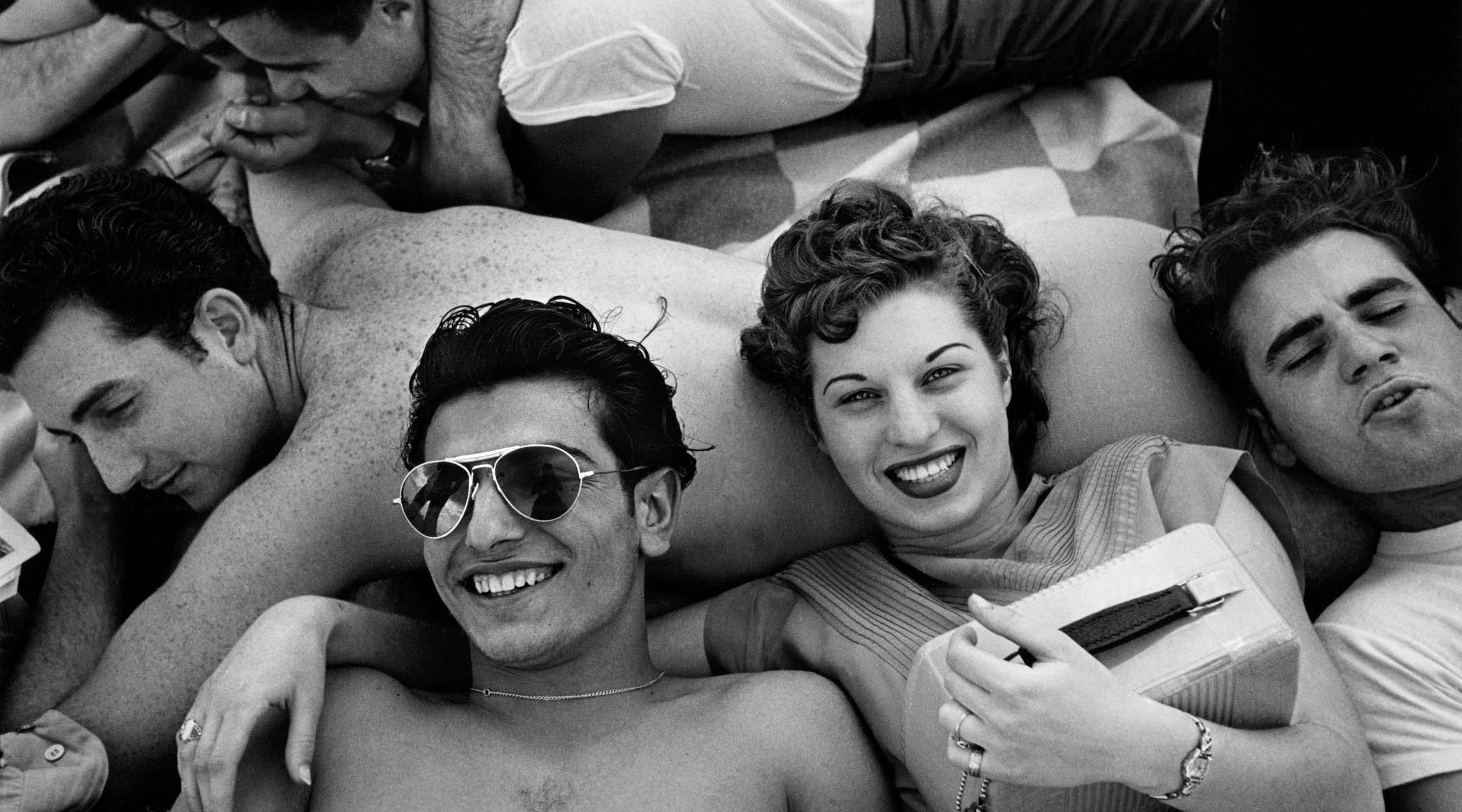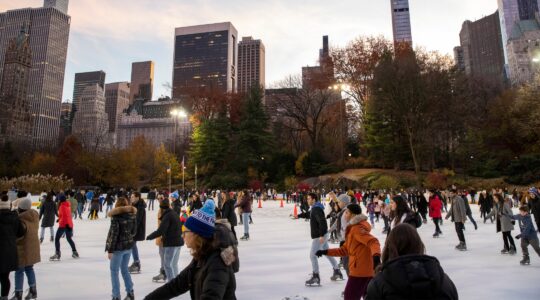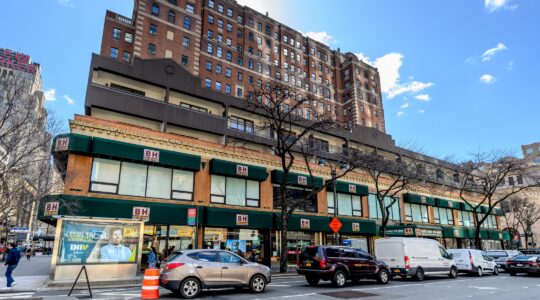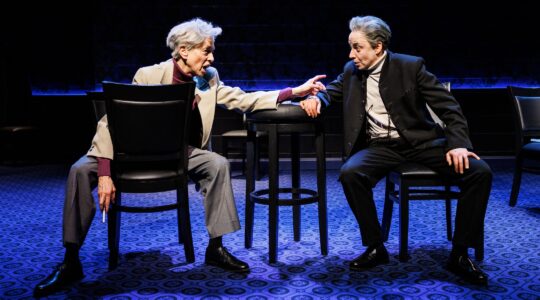(New York Jewish Week) — A multi-generational group of people congregate on a building stoop on Hester Street; an African-American man leans on a lamppost; a gaggle of teenagers pile on top of each other at the beach in Coney Island; a horde of children — in various states of undress — play with a broken mirror in the street.
These are only a few examples of the 150 black-and-white snapshots of New York City street life in the 1930s and ’40s that appear in the new book “Walkers in the City: Jewish Street Photographers of Midcentury New York” by historian and scholar Deborah Dash Moore. The photos are the work of the New York Photo League, a group of socially conscious street photographers whose aim was to showcase the living conditions of the city’s working class, as well as spotlight their everyday lives and relationships.

New York, ca. 1940. (Helen Levitt)
The Photo League operated in New York from 1936 until 1951; the cooperative of like-minded photographers ceased to exist after it was placed on a Department of Justice blacklist in 1947 on the suspicions that it had anti-American, communist associations. Most of the photographers in the league were left-wing and working class. Many of them were also Jewish — immigrants or the children of immigrants from Russia and Eastern Europe.
Members of the Photo League included well-known Jewish photographers like Sol Libsohn, Sid Grossman, Morris Engel, Harold Feinstein, Helen Levitt, Weegee (born Usher Felig) and a young Marvin E. Newman (who died this month at age 95). “Touched by left-wing radicalism that flourished among second-generation Jews in the 1930s, these photographers considered photography a social and political tool,” Dash Moore writes in the book’s prologue. “It could influence how people interpreted their conditions.”
In “Walkers in the City,” Dash Moore explores how these photographers’ Jewish sensibilities allowed them to capture both intimate and hectic moments of New Yorkers’ everyday lives. “A focus on their fellow New Yorkers affirmed the capability of photography to help them grasp their world,” Dash Moore writes. “And with understanding came the potential power to change society.”
The New York Jewish Week caught up with Dash Moore via Zoom from Ann Arbor, Michigan, where the New York City native is a professor of history and Judaic studies at the University of Michigan. We spoke about the genesis of the book, her favorite images from the collection and how the photographers’ Judaism had impacted their work.
This interview has been lightly edited for length and clarity.
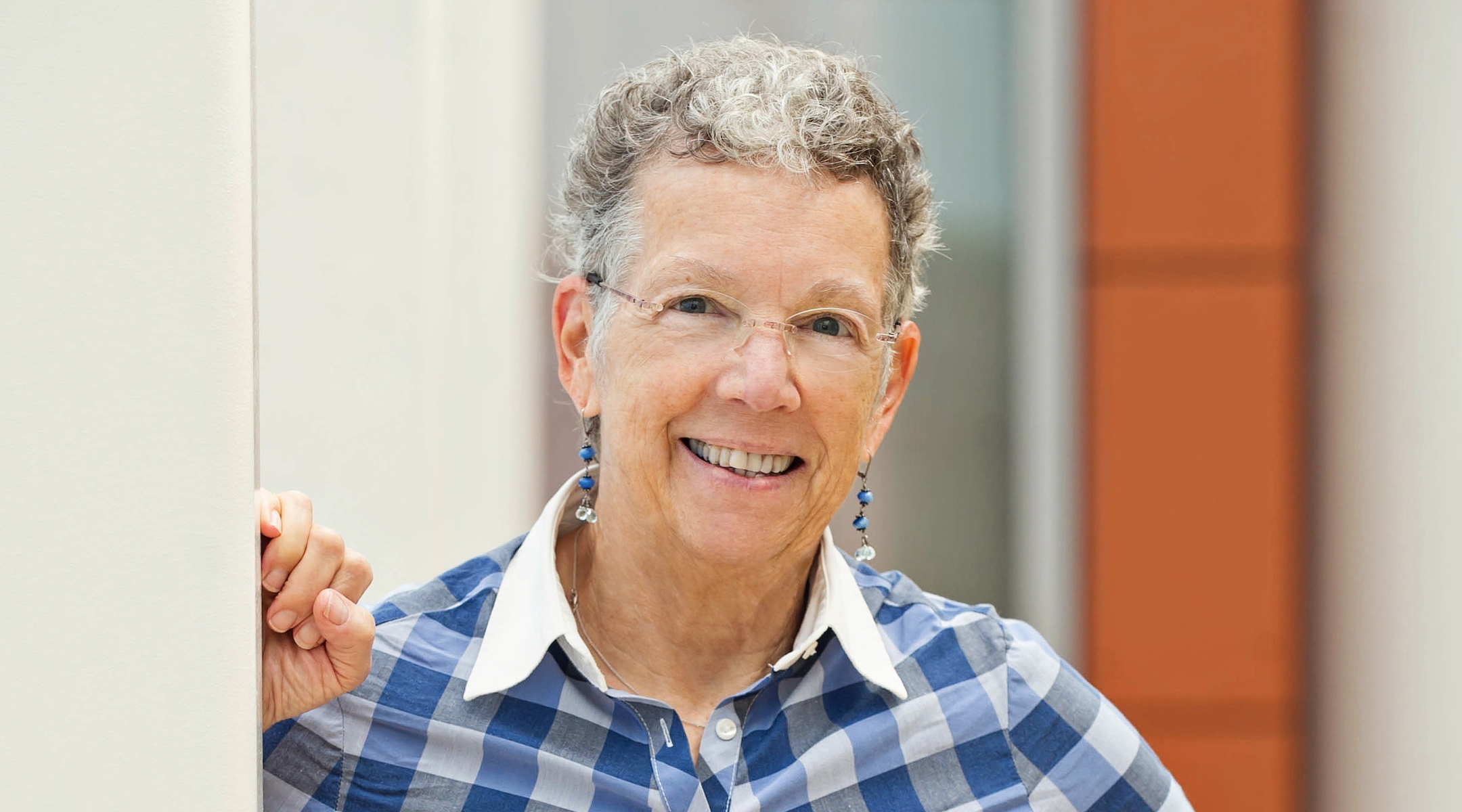
Historian Deborah Dash Moore is the author and editor of several books, including “GI Jews: How World War II Changed a Generation” and “City of Promises: A History of the Jews of New York.” Her most recent book is “Walkers in the City: Jewish Street Photographers of Midcentury New York.” (Courtesy)
What drew you to this subject of documentary photography and the New York Photo League?
I co-authored a book — that was not a Jewish book — on New York that came out in 2001. It was called “Cityscapes: A History of New York in Images.” I could have used prints — my co-author, who had the earlier half of the book, used a lot of print sources and stuff like that — but I was intrigued with the photographs. However, we had no money — we had like $25 for permission to publish a photo. So we wrote this very nice letter to all these different photographers, and a bunch of them said, “You must be kidding,” and “no.”
But then there were others who said, “OK, where do you see my stuff?” I said, “Well, the New York Public Library, Museum of the City of New York.” They said, “Oh, that’s only a small piece of what I produce. You have to come to my studio.” So I started to go to these photographers’ studios. This would have been in the late 1990s, because the book came out in 2001. So we’ve got these studios and I’m seeing lots of great photos and after a while it’s dawning on me: “Oh, this one’s Jewish, that one’s Jewish, the other one is Jewish. These people, these photographers, they’re all so Jewish. That was sort of lodged in the back of my head.
Twelve years or so ago, I had a fellowship at the Frankel Institute for Advanced Judaic Studies at the University of Michigan. The theme that year was “Jews and the City” and it was at that point I thought, OK, let’s look at urban photography and Jews.

Hester Street, 1938. (Sol Libsohn)
The New York Photo League wasn’t specifically a Jewish group. Is this a new thesis that you’re offering, that their photos presented a very Jewish way of looking at the city? Or do you think they saw themselves that way?
No, they didn’t see themselves that way. They had far more conventional understandings of what it means to be Jewish: You had to be religious, you had to keep kosher. They didn’t fit any of those categories, so they did not see themselves that way. So yes, I am suggesting that this was basically a Jewish group. Now, does that mean that everybody there was Jewish? No, of course not. But it did mean that the non-Jews who joined the Photo League were comfortable in what was essentially a Jewish milieu. They were comfortable being around Jews. The Photo League was a Jewish organization in that way, in my terms.
The styles of talking about photographs, the way in which they decided what made for a good photograph, what was important to photograph — all these things were essentially inflected by Jewish concerns at the time in the 1930s and ’40s. Many of them were political concerns. This is the middle of the Great Depression — so they were about how you create a more just society in New York City. How do you deal with the incredible exploitation and inroads of capitalism that leave so many people impoverished?

“Soul of New York,” 1951-1952. (Louis Stettner)
Many of them, of course, came out of poor homes. They knew a lot of economic insecurity themselves. These were among their specific concerns. They also were very much aware that the standard pictures of New York City, which were produced by companies to make a lot of money, were pictures of the Empire State Building and of the Statue of Liberty and of the famous things like the skyline, et cetera. To them, that was not New York. New York, to them, was its people. So you had to figure out, how do you take pictures of the people of New York? One could be even more specific: It was the working-class people. These were the people who made New York.
Do you have a favorite photo in the book?
I love most of the pictures in the book, which is why they’re in the book. I really liked the cover picture. I think that [Morris] Engel’s photograph “East Side Sweet Evelyn” really captures New York in the late ’30s. But also it’s a real Photo League photo. I mean, how do you know it’s New York? Well, the guy is going down into the subway. The advertising has this great picture of “eyes examined” and this man looking at a woman. It speaks to the power that men have to look at women, which happens all the time on the streets of New York. It speaks to what I call “the circulation of gazes.” That also happens in New York. The woman, we can be pretty sure, knows she’s being looked at, although she looks straight ahead. This very much epitomizes New York. It says “the city” in so many different ways.

A woman passing by with a box labeled “Sweet Evelyn” catches the eye of a man making his way down subway stairs, New York, 1938. (Morris Engel)
The photographers themselves were really aware of what their presence meant, and aware of how they were capturing people’s experiences. When they took photographs, they wanted people to get a chance to see those photographs. So they often came back regularly to the neighborhood and they handed out prints to people. They felt that there was a reciprocity that was important. I think that piece, and the emotions connected with that, are really important. That was very much in the Jewish, New York, Photo League spirit. It’s not a candid that you’re snapping and that you’re never going to relate to that person again.
What are you hoping that non-Jews or non-New Yorkers will take away from your curation of these photos?
I hope that they take away a sense of the vibrancy of the time — of the ways in which people made connections and developed an appreciation of each other, and a sense of how this was fostered by the city. There’s so much anti-city stuff that exists. But the City of New York was a place that fostered this kind of interconnection, where you could learn about people who were different from you. Most of the photographs that these photographers took were not of Jews, but they were of New Yorkers. It was a way, in a sense, to come to understand your neighbors and how to be a neighbor.
So many people find cities frightening. They don’t know how to deal with the diversity of cities. They don’t know how to deal with differences. There’s fear and paranoia. Photographers said: “No, don’t be afraid.”
“Walkers in the City: Jewish Street Photographers of Midcentury New York” was published Sept. 15 by Cornell University Press. Dash Moore will be in conversation with Manhattan Borough Historian Robert W. Snyder at the Center for Jewish History on Thursday, Sept. 28.
The New York Jewish Week brings you the stories behind the headlines, keeping you connected to Jewish life in New York. Help sustain the reporting you trust by donating today.
